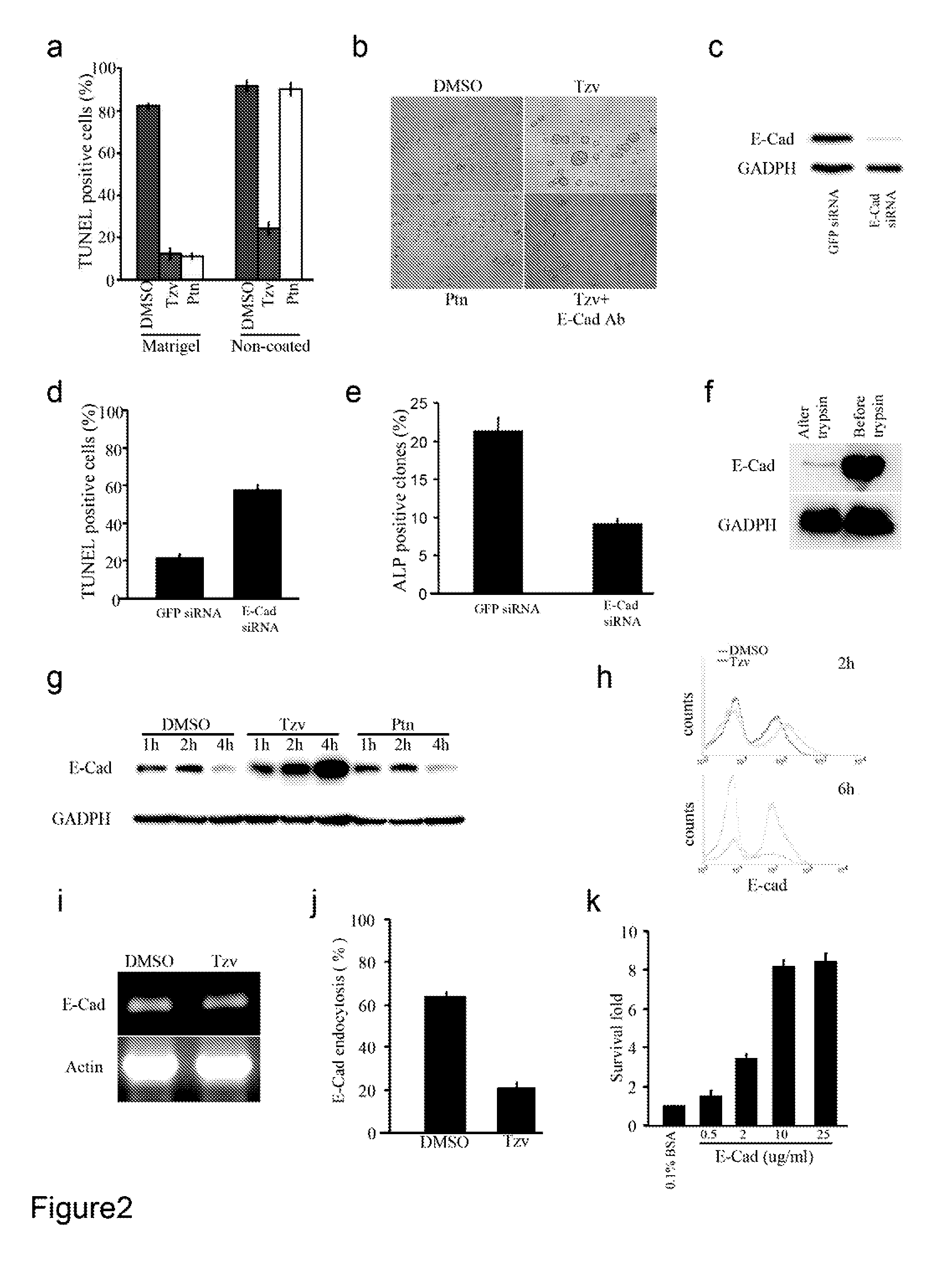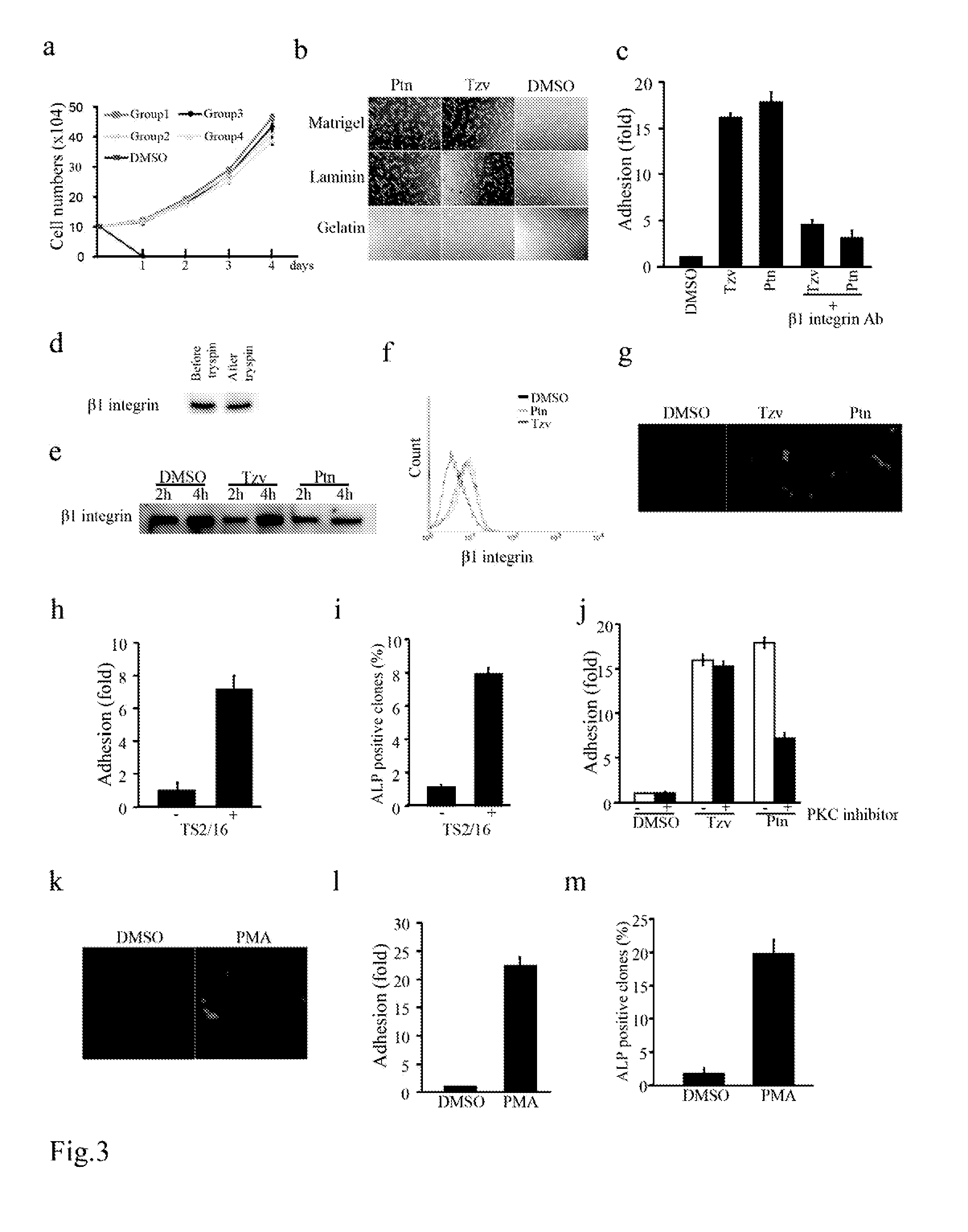Stem cell cultures
a stem cell and culture technology, applied in the field of stem cell cultures, can solve the problems of undergoing extensive cell death, not acting as a survival factor in this process, and still largely unsatisfactory, and achieve the effect of improving the survival rate of isolated stem cells and improving the survival rate of cells
- Summary
- Abstract
- Description
- Claims
- Application Information
AI Technical Summary
Benefits of technology
Problems solved by technology
Method used
Image
Examples
example 1
[0220]To improve chemically-defined medium conditions and uncover the molecular mechanism of hESC death after single cell dissociation, we performed a high throughput phenotypic screen of 50,000 synthetic compounds to identify small molecules that promote hESC survival after trypsin dissociation. From the screen, two chemical classes were identified that significantly increased the cell survival after dissociation and also maintained hESC colony morphology and alkaline phosphatase (ALP) expression. Further chemical optimizations and activity analysis resulted in the discovery of two lead molecules, a 2,4-disubstituted thiazole (named as Thiazovivin / Tzv) and a 2,4-disubstituted pyrimidine (named as Pyrintegin / Ptn) (FIG. 1a), for further functional and mechanistic characterizations.
[0221]
TABLE 1Activity DataActivity (% ALP positive colony formationCompoundby hESCs)124.14.55.220.3523.523.282.95.73.16.26.13.53.63.233.43.15.23.13.33.33.11Ratio of ALP positive colonies vs. total initially...
example 2
Synthesis of N-benzyl-2-(pyrimidin-4-ylamino)thiazole-4-carboxamide (Thiazovivin)
[0246]Using the chemical synthesis examples presented below and chemical synthesis methods generally known in the art, one of skill is capable of making the compounds disclosed herein (e.g. the compounds of Formulae (I) to (VI)).
[0247]All chemicals obtained commercially were used without further purification. NMR spectra were recorded on a Bruker (400 MHz) instrument. Chemical shifts (δ) were measured in ppm and coupling constants (J) are reported in Hz. LCMS was performed by reverse-phase liquid chromatography-mass spectrometer Agilent 1100 LCMS system with API-ES ionization source. High pressure liquid chromatography was performed with C18 column with a linear gradient from 10% solvent A (acetonitrile with 0.035% trifluoroacetic acid) in solvent B (water with 0.05% trifluoroacetic acid) to 90% A in seven and half minutes, followed by two and half minutes elution with 90% A.
Synthesis ...
example 3
Synthesis of Thiazovivin Derivatives
[0252]
[0253]Appropriate amines R1NH2 were pre-loaded to 4-formyl-3,5-dimethoxyphenoxymethyl functionalized polystyrene resin (PAL) via reductive amination to give PAL-benzyl amine resin. A mixture of PAL-benzyl amine resin (200 mg, 0.2 mmol, 1.0 eq.), 2-bromothiazole carboxylic acid 1 (0.4 mmol, 2.0 eq.), bis(2-oxo-3-oxazolidinyl)phosphinic chloride (BOP-Cl) (0.6 mmol, 3.0 eq.) and diisopropylethylamine (1 mmol, 5.0 eq.) in anhydrous DMF (3 mL) was shaken for 24 hr at ambient temperature. The resin was washed with methanol, dichloromethane and dried in vacuo, which was then added to a flame-dried reaction vial, followed by corresponding R2NH2 (1 mmol, 5.0 eq.), Pd2(dba)3 (0.05 mmol), Xantphos (0.15 mmol) and NaOtBu (2 mmol, 10.0 eq.). The vial was sure safe capped and degassed, then charged with argon and anhydrous dioxane (1.5 mL). The reaction was shaken for 24 hours at 90° C. The resin was washed with sodium diethyldithiocarbamate solution (0.0...
PUM
| Property | Measurement | Unit |
|---|---|---|
| time | aaaaa | aaaaa |
| time | aaaaa | aaaaa |
| time | aaaaa | aaaaa |
Abstract
Description
Claims
Application Information
 Login to View More
Login to View More - R&D
- Intellectual Property
- Life Sciences
- Materials
- Tech Scout
- Unparalleled Data Quality
- Higher Quality Content
- 60% Fewer Hallucinations
Browse by: Latest US Patents, China's latest patents, Technical Efficacy Thesaurus, Application Domain, Technology Topic, Popular Technical Reports.
© 2025 PatSnap. All rights reserved.Legal|Privacy policy|Modern Slavery Act Transparency Statement|Sitemap|About US| Contact US: help@patsnap.com



